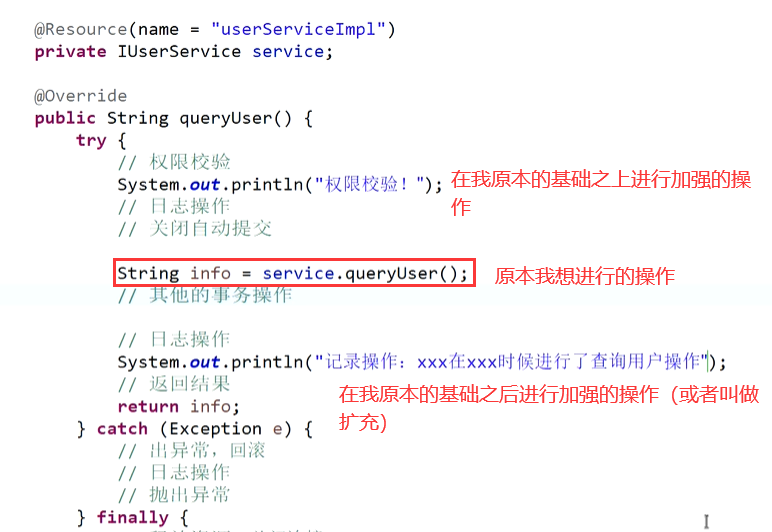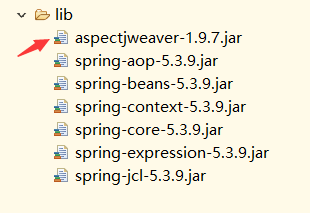Learning AOP in Spring is to realize relevant interception and cut in functions through configuration (XML based configuration and annotation based configuration). Strengthen the original operation, but do not affect the original operation.
catalogue
3. Learning can be roughly divided into two categories
4.xml environment configuration
7.IUserService interface implementation class
9.aop configuration explanation:
1. Understanding: This is the case with Aop's enhancement. You just want to query users, but I'll expand your process during your process. (Xiaobian's personal understanding)

 2. Required jar packages
2. Required jar packages
3. Learning can be roughly divided into two categories
(1) Pre, post, exception, final
- Pre notification: executed before the pointcut method is executed
- Post notification: executed after the pointcut method executes normally. It and exception notification can always be executed only once
- Exception notification: executed after an exception is generated during pointcut method execution. It and post notification can always execute only one
- Final notification: the pointcut method executes after it whether it executes normally or not
(2) Surround
- Previously, when to execute the enhanced code was specified by configuration, but now it is specified by code control.
- Therefore, surround notification is a way provided by the Spring framework to manually control when the enhanced method is executed in the code.
4.xml environment configuration
<?xml version="1.0" encoding="UTF-8"?> <beans xmlns="http://www.springframework.org/schema/beans" xmlns:xsi="http://www.w3.org/2001/XMLSchema-instance" xmlns:aop="http://www.springframework.org/schema/aop" xsi:schemaLocation="http://www.springframework.org/schema/beans https://www.springframework.org/schema/beans/spring-beans.xsd http://www.springframework.org/schema/aop https://www.springframework.org/schema/aop/spring-aop.xsd"> <bean id="userServiceImpl" class="com.bookmanagesystem.service.impl.UserServiceImpl"></bean> <bean id="mylogger" class="com.bookmanagesystem.util.MyLogger"> </bean> <aop:config> <aop:pointcut expression="execution(* com.iflytek.bookmanagesystem.service.impl.*.*(..) )" id="pc1" /> <!-- 3. Configure section --> <aop:aspect id="logAdvice" ref="mylogger"> <!-- Configure the type of notification (original method) --> <!-- <aop:before method="printLog" pointcut-ref="pc1" /> <aop:after-returning method="printLog" pointcut-ref="pc1" /> --> <!-- <aop:before method="printLog" pointcut="execution(public void com.bookmanagesystem.service.impl.UserServiceImpl.delete() )" /> --> <!-- 1. Configure pre notification --> <!-- <aop:before method="beforePrintLog" pointcut-ref="pc1" /> --> <!-- 2. Configure post notification --> <!-- <aop:after-returning method="afterReturningPrintLog" pointcut-ref="pc1" /> --> <!-- 3. Configure exception notification --> <!-- <aop:after-throwing method="afterThrowingPrintLog" pointcut-ref="pc1" /> --> <!-- 4. Configure final notification --> <!-- <aop:after method="afterPrintLog" pointcut-ref="pc1" /> --> <!-- 5. Configure surround notifications --> <aop:around method="aroundPrintLog" pointcut-ref="pc1" /> </aop:aspect> </aop:config> </beans>
5.main function call
public static void main(String[] args) {
// 1. Get the core container object
ApplicationContext context = new ClassPathXmlApplicationContext("applicationContext.xml");
// 2. Get the bean object according to the id
IUserService service = (IUserService) context.getBean("userServiceImpl");
service.update();
// 3. Close the container (if you don't remember to close the container, the most typical problem is that the database connection cannot be released)
((ClassPathXmlApplicationContext) context).close();
}6.IUserService interface
public interface IUserService {
void update();
// Simulate update user action
}7.IUserService interface implementation class
public class UserServiceImpl implements IUserService {
//Simulated
@Override
public void update() {
System.out.println("Modify the user's operation");
}
}8. Weave in the file MyLogger
public class MyLogger {
/**
* It is used to print the log and let it execute before the execution of the pointcut method (the pointcut method is the business method)
*/
// Before advice
public void beforePrintLog() {
System.out.println("Before advice MyLogger Class beforePrintLog Method starts logging...");
}
// Post notification
public void afterReturningPrintLog() {
System.out.println("Post notification MyLogger Class afterReturningPrintLog Method starts logging...");
}
// Exception notification
public void afterThrowingPrintLog() {
System.out.println("Exception notification MyLogger Class afterThrowingPrintLog Method starts logging...");
}
// Final notice
public void afterPrintLog() {
System.out.println("Final notice MyLogger Class afterPrintLog Method starts logging...");
}
//Around Advice
public Object aroundPrintLog(ProceedingJoinPoint pjp) {
Object result = null;
try {
Object[] args = pjp.getArgs(); // Get the parameters required for method execution
System.out.println("Surround notification logging");
result = pjp.proceed(args); // Explicitly invoke business layer methods (pointcut methods)
System.out.println("Surround notification log post");
return result;
} catch (Throwable e) { // The processed method throws Throwable, which can't be stopped with Exception here
System.out.println("Circular notification logging exception");
e.printStackTrace();
throw new RuntimeException(e);
} finally {
System.out.println("Final notification record date");
} }
}
9.aop configuration explanation:
< Aop: config > / / indicates that I have started configuring Aop
<aop:pointcut expression="execution(* com.bookmanagesystem.service.impl.*.*(..) )"
Id = "pc1" / > / / 1. A simple way to write it can also be written as the specific above. 2. I named "pc1" for all the methods under my bookmanagesystem.service.impl.UserServiceImpl. Package
<!-- 3. Configuration section -- >
< AOP: aspect id = "logadvice" ref = "mylogger" > / / ref let me link my aspect with the woven file for enhancement
< AOP: around method = "around printlog" pointcut ref = "pc1" / > / / the surrounding method is the public object around printlog (proceedingjoinpoint PJP) {} method in my MyLogger class, because pc1 contains all the methods I wrote under the package com.bookmanagesystem.service.impl
</aop:aspect>
</aop:config>